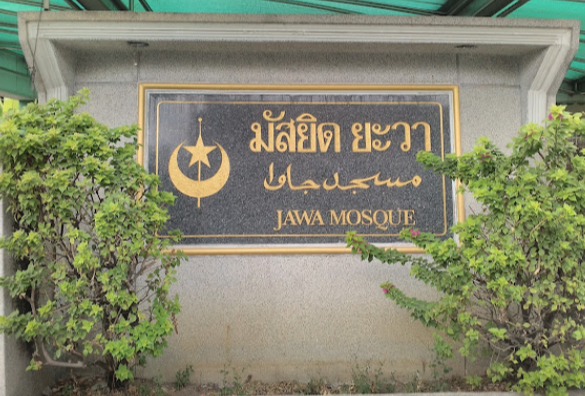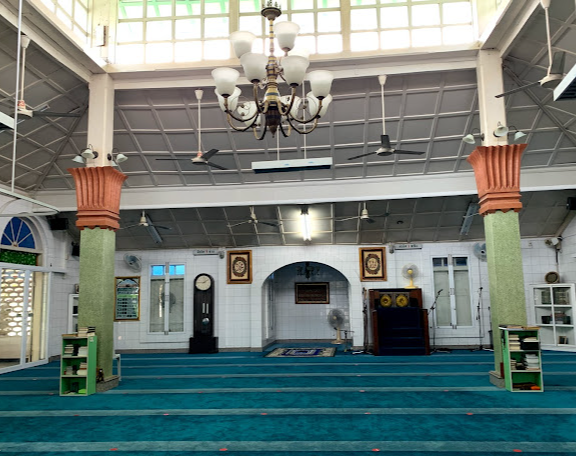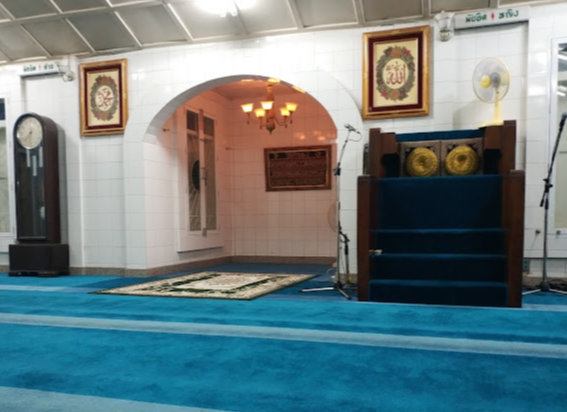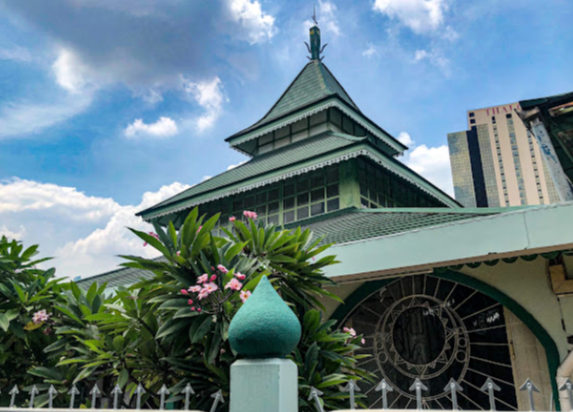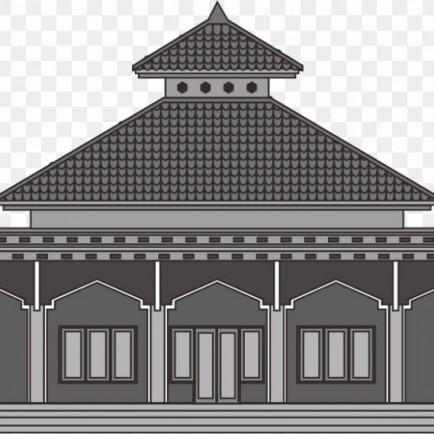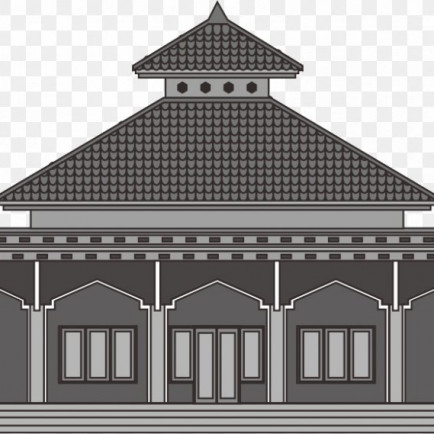Jawa Mosque
History
“Yawa” is the name of a Muslim community in Bangkok. used to refer to their own group, the name “Yawa”, is known to the Thais as “Java”, a Muslim who comes from the island of Java. Indonesia pronounces the word Java as "yawa" according to the accent used in their hometown. Official documents during the reign of King Chulalongkorn The words Java and Yawa are mixed with each other. But it is understood that they are the same community. Even today, the name of the place where religious ceremonies is performed, known as “masjid”, is officially registered in the name of the Yawa Masjid.
The Yawa people have land in Soi Rong Ngei, South Sathorn Road (Soi Charoen Rat, Sathorn Road), Yan Nawa Subdistrict, Sathorn District. D means the village But for the elderly Ywa people often call their village "Sungei Baru" (Sungei Baru), meaning new, the meaning of the new is Sathorn canal itself.
When some of the Yawa people moved to Khlong Sathorn (South Sathorn) area, in the beginning there was no place to worship the Lord Buddha together. Probably used one of the houses as a place of worship. The Javanese force Holland. Which is located in the area of Alley Rong Ice, Sathorn Road, Kok Krabue Sub-district, Bang Rak District (currently Yannawa Sub-District, Sathorn District) has given the land to be a place for building a mosque. to use as a place of worship to God This land belonged to a Chinese named Joi 1945 Ajyi Muhammad Sa and Ah. has submitted a request to the authorities to change the title deed for this new land By using the name of Ajji Muhammad Zaw as the manager of the mosque. Javanese people in the area such as Mr. Muhammad Musa, Mr Raqa and other Javanese people. both in the village and outside the village jointly established the Yawa Mosque to be the Yawa style architecture. Although the mosque was repaired 2 times, the first in the budget of 1927 and the second around the year B.E. 1975 still maintains the original roof shape Only the mosque building was changed to make it wider. especially at the seat of Dharma discussion which the Javanese call this area that they stay in Balai (Balai).
However, the Yawa Mosque was used as a place of worship to God, with the Imam serving as the religious leader in the mosque until 1996, a total of 6 people, including Javanese and Muslims of Malay descent. in the same village is Ayyi Abdul Raman (Yawa), Ajyi Ismael (Malay), Ajyesughaimi, Imam Nuyup (Yawa), Ajyi Abdul Rahman or Ajji Arun Pitayay. Na (Malay) is the Imam of the Masjid Yawa based on the descent of each maam. It can be seen that both Javanese and Malays perform duties, with both Javanese and Malay Muslims in the same village. And Muslims in Soi Wat Prok use the Yawa Mosque. It has also been a place of worship since the completion of the mosque.
Urban and Architectural
This mosque has a Javanese architecture with a light green building color with a pyramid roof with three steps. At a glance, it feels like seeing the Great Mosque of Kauman in Yogyakarta in a mini size.
The main building of the mosque is in the form of a rectangle measuring 12 x 12 meters with four pillars in the middle which serve as supports. In addition to the side of the Qibla direction, on the other three sides there are three wooden doors each. Outside the main building, there is a foyer with four doors made of iron bars. At the front ( mihrab ), there is a wooden pulpit equipped with stairs. On the right and left there are two clock bells, also made of wood.
There are two main buildings, namely a mosque and a madrasa in the form of a house on stilts with various rows of chairs and tables under the house. While opposite the mosque there is an Islamic cemetery. The interior of the mosque really made me feel like I was in an old mosque in Java. Ornaments of poles, ceilings, pulpits and window trellises, very Indonesian style. The place for ablution also looks unique. On the left side of the mosque there is an inscription of the inauguration of the mosque in Thai. During Friday prayers the congregation can reach 200 people.
Jawa Mosque has a madrasa with 100 students. They hold Quran recitations on Sundays for adults and children on Monday-Friday. In this Javanese village also lives the grandson of KH Ahmad Dahlan , the founder of Muhammadiyah as well as an Indonesian Islamic figure. The name of the grandson is Walidah Dahlan
Description
Jawa Mosque a mosque in Bangkok , Thailand . This mosque is called the Javanese mosque because it was founded by the Javanese in Bangkok. This mosque was founded on a waqf land belonging to Haji Muhammad Saleh, an overseas Javanese in 2448 in the year Thailand or around 1906
Details
Location
Soi Charoen Rat 1 Yaek 9, Yan Nawa, Sathon, Bangkok 10120, Thailand
Worshippers
200
Owners
Haji Muhammad Solih
Year of Build
1905
Area
450
Drawings
Map
History
“Yawa” is the name of a Muslim community in Bangkok. used to refer to their own group, the name “Yawa”, is known to the Thais as “Java”, a Muslim who comes from the island of Java. Indonesia pronounces the word Java as "yawa" according to the accent used in their hometown. Official documents during the reign of King Chulalongkorn The words Java and Yawa are mixed with each other. But it is understood that they are the same community. Even today, the name of the place where religious ceremonies is performed, known as “masjid”, is officially registered in the name of the Yawa Masjid.
The Yawa people have land in Soi Rong Ngei, South Sathorn Road (Soi Charoen Rat, Sathorn Road), Yan Nawa Subdistrict, Sathorn District. D means the village But for the elderly Ywa people often call their village "Sungei Baru" (Sungei Baru), meaning new, the meaning of the new is Sathorn canal itself.
When some of the Yawa people moved to Khlong Sathorn (South Sathorn) area, in the beginning there was no place to worship the Lord Buddha together. Probably used one of the houses as a place of worship. The Javanese force Holland. Which is located in the area of Alley Rong Ice, Sathorn Road, Kok Krabue Sub-district, Bang Rak District (currently Yannawa Sub-District, Sathorn District) has given the land to be a place for building a mosque. to use as a place of worship to God This land belonged to a Chinese named Joi 1945 Ajyi Muhammad Sa and Ah. has submitted a request to the authorities to change the title deed for this new land By using the name of Ajji Muhammad Zaw as the manager of the mosque. Javanese people in the area such as Mr. Muhammad Musa, Mr Raqa and other Javanese people. both in the village and outside the village jointly established the Yawa Mosque to be the Yawa style architecture. Although the mosque was repaired 2 times, the first in the budget of 1927 and the second around the year B.E. 1975 still maintains the original roof shape Only the mosque building was changed to make it wider. especially at the seat of Dharma discussion which the Javanese call this area that they stay in Balai (Balai).
However, the Yawa Mosque was used as a place of worship to God, with the Imam serving as the religious leader in the mosque until 1996, a total of 6 people, including Javanese and Muslims of Malay descent. in the same village is Ayyi Abdul Raman (Yawa), Ajyi Ismael (Malay), Ajyesughaimi, Imam Nuyup (Yawa), Ajyi Abdul Rahman or Ajji Arun Pitayay. Na (Malay) is the Imam of the Masjid Yawa based on the descent of each maam. It can be seen that both Javanese and Malays perform duties, with both Javanese and Malay Muslims in the same village. And Muslims in Soi Wat Prok use the Yawa Mosque. It has also been a place of worship since the completion of the mosque.
Urban and Architectural
This mosque has a Javanese architecture with a light green building color with a pyramid roof with three steps. At a glance, it feels like seeing the Great Mosque of Kauman in Yogyakarta in a mini size.
The main building of the mosque is in the form of a rectangle measuring 12 x 12 meters with four pillars in the middle which serve as supports. In addition to the side of the Qibla direction, on the other three sides there are three wooden doors each. Outside the main building, there is a foyer with four doors made of iron bars. At the front ( mihrab ), there is a wooden pulpit equipped with stairs. On the right and left there are two clock bells, also made of wood.
There are two main buildings, namely a mosque and a madrasa in the form of a house on stilts with various rows of chairs and tables under the house. While opposite the mosque there is an Islamic cemetery. The interior of the mosque really made me feel like I was in an old mosque in Java. Ornaments of poles, ceilings, pulpits and window trellises, very Indonesian style. The place for ablution also looks unique. On the left side of the mosque there is an inscription of the inauguration of the mosque in Thai. During Friday prayers the congregation can reach 200 people.
Jawa Mosque has a madrasa with 100 students. They hold Quran recitations on Sundays for adults and children on Monday-Friday. In this Javanese village also lives the grandson of KH Ahmad Dahlan , the founder of Muhammadiyah as well as an Indonesian Islamic figure. The name of the grandson is Walidah Dahlan
Description
Jawa Mosque a mosque in Bangkok , Thailand . This mosque is called the Javanese mosque because it was founded by the Javanese in Bangkok. This mosque was founded on a waqf land belonging to Haji Muhammad Saleh, an overseas Javanese in 2448 in the year Thailand or around 1906


